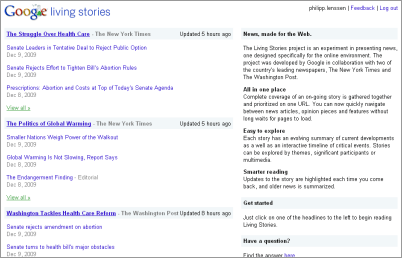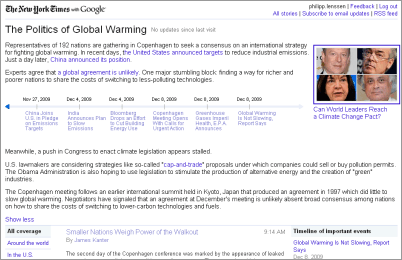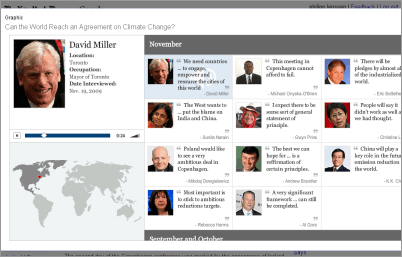Sent to you by john taube via Google Reader:
 Let's say you're a butcher, a baker or a candlestick maker. You want to get up to speed on the social media activity in your market, as fast as you can. Or perhaps you want to sell things to candlestick makers online, or you're a journalist writing a story about blogging butchers, or maybe you've got some kind of weird baking fetish or academic interest.
Let's say you're a butcher, a baker or a candlestick maker. You want to get up to speed on the social media activity in your market, as fast as you can. Or perhaps you want to sell things to candlestick makers online, or you're a journalist writing a story about blogging butchers, or maybe you've got some kind of weird baking fetish or academic interest.
Is there any way to ramp up your knowledge of these fields, fast, other than the "Google and wander" method? We think there is. Below you'll find step-by-step instructions, with screen shots, for the process we use when we want to get smart about a new field in a hurry.

Editor's note: This story is part of a series we call Redux, where we'll re-publish some of our best posts of 2009. As we look back at the year - and ahead to what next year holds - we think these are the stories that deserve a second glance. It's not just a best-of list, it's also a collection of posts that examine the fundamental issues that continue to shape the Web. We hope you enjoy reading them again and we look forward to bringing you more Web products and trends analysis in 2010. Happy holidays from Team ReadWriteWeb!
Works With Just About Anything
We'll use the field of Education as our example, because there is a lot of activity there and we presume we've got more educators as readers here than butchers or candlestick makers. These methods can be applied to discovering the hottest people and topics in social media in any field, though.
If you doubt that these kinds of steps could help in your line of work - check out this post, where we found the best work-related RSS feeds for Fire Inspectors and Physical Therapists, just to prove that we could.
In the following 13 steps, we'll walk you through how we identify top blogs on any topic, how we quickly figure out what their most popular recent posts have been about, how we incorporate their blog archives into our knowledge about the field and how we find where else they are participating in conversation around the web. Going through the whole process takes us less time than it took us to write this post.
No end of variations are possible, of course, on this method - but we expect a lot of readers will find this useful. People new to social media are often frustrated when they are told to "join the conversation" - because they aren't sure where to find the conversation. Here's how we find and track the most popular conversations in niche fields. Popularity isn't a perfect judge of quality by any means, but it's a good place to start from.
Is this post a cheat sheet? Maybe, but we think of it as a way for you to make your cheat sheet on whatever sector you follow.
Find The Most Popular Blogs in Your Field

There are many different ways to identify the top blogs in a given field, systematically, but some methods work better than others depending on the niche you're looking at. We compared six of our favorite methods in this post. Here, we found that visiting http://delicious.com/tag/blog+teaching gave us good results. By default the URLs are listed in reverse chronological order - the most recent items that anyone has bookmarked and have ever been called both "blog" and "teaching" will appear first. In the image above you can see that we're running two Greasemonkey scripts called Autopagerize and Sort By Popularity. Greasemonkey is really easy to use, see our post How to Learn to Use Greasemonkey in 5 Minutes.. These scripts let us open multiple pages of bookmarks all at once and then sort them in order of popularity.
So we did that, then scanned down the top several pages of most popular items tagged both "blog" and "teaching." We tried words other words like "education" as well. Each time we found a good site, we copied the link to it and went to step two.
Add The Feeds to a Reader

We like to use Netvibes to build collections of feeds because it's easy. Click on "add items" then "add feed" and paste in the link to the top blog you found. Netvibes will auto-discover the RSS feed for the site, often multiple variations but it shouldn't matter which one you choose. We pick "RSS 2.0" just because it's the most standard. Add it to your page and then go back to Delicious to find more sources.
We repeated the discovery step until we found about 10 good blogs to subscribe to. Then we visited those blogs and looked at their "blogrolls" or sidebar links to their favorite blogs. We found a number of good sources to include in our list that we had never heard of before. One was a good looking blog about education and technology that was written in Spanish, so we grabbed its feed and ran it through Mloovi.com to have it automatically translated into English, then put that translated feed into Netvibes.
Once you've got a good collection of top blogs in that Netvibes "tab" it's time to get it out of there. You can read the blogs in Netvibes, but there's more that we're going to do with these blogs. When you're in the "add feed" screen, you'll see an "OPML Export" link. OPML (Outline Processor Markup Language) is the format that reading lists are imported and exported from feed readers in. It's really simple. Export it to your dekstop and then move onto the next step below. We're now going to edit an OPML file - but don't be scared! It's easy, we promise. Anyone can do it.
Pull Out Your New Tab's Feeds

This step assumes you've using Netvibes, or some other start page, for other things in addition to this project. If that's not the case, skip to the next step. We use Netvibes for a number of different things, so when we put together a new collection of feeds in it and want to export them, we have to deal with the fact that our whole collection of feeds in all our tabs gets exported. Simply search for the title of your tab in the file, then delete everything outside of that section! Everything except the very beginning and end of the file, that is. You can see what it should look like below, in the next step.
The Top of the OPML File.

Don't delete the document type declaration of the body tags. Rename the title of the file and resave your document. Now don't you feel smart? That was really easy though!
Now to Find the Hottest Posts from Those Top Blogs

Now that you've got an OPML file of the most popular blogs in your field, you can take that file over to Postrank.com and import it. You'll need to create an account, and the service doesn't allow you to manage multiple OPML files, so you may need to create a new account for every time you do something like this. I just create a new account with a GMail alias. Did you know that as while other apps, like Postrank, think that emailmarshall@gmail.com, emailmarshall+1@gmail.com and emailmarshall+2@gmail.com are all different emails - Gmail considers them the same thing? It's true, that's an alias and all emails sent to any of those will end up in the same inbox. So I create a new account for each OPML file (silly, but that's how you've got to do some of these things) and then import my new OPML file.
Rank the Blog Posts With Robots!

Once you import that OPML file from your desktop, you'll probably notice that Postrank has seen some of the feeds and not seen others. You should probably come back in an hour once they've processed the remaining feeds. What are they doing? They are checking every item in every feed to see how many comments it has, how many inbound links, how man times it's been bookmarked in Delicious or Digg, how many times people Tweeted about it, etc. It's then ranking each item in each feed on a scale of 1 to 10, relative only to the other items in that same feed.
What does this mean? It means you can have Postrank show you only the most popular posts in each of these top blogs, as determined by the blogs' own communities of readers. That's valuable information! It's a very fast way to get up to speed on the latest hot topics in your field and by subscribing to the feeds filtered for popular items, you can pay peripheral attention to this field but know that you'll never miss a really big story. Thanks Postrank!
If you're interested in the Greatest Hits of Top Education Bloggers, here's the OPML file we built with the feeds we've found so far: Top Education Blogs - Greatest Hits. Just right click and save that link, then upload it to your feed reader.Banish Content Overload

By selecting all the feeds in your collection, then setting their filter to "great" - you'll be shown just the hottest posts from each blog. Selecting "best" will show you almost nothing at all, though. Once you've set the filter to Great, export this filtered version of your OPML file and move on to the next step!
Pretty Up Your Collection

We would recommend opening this new OPML file in your text editor and renaming it something more useful.
Check Out the Hotness

By clicking on any of the feeds you imported into Postrank, you can check out the hottest posts in that blog's recent history. Hello time saver! Some of you might be temped to call it a day at this point, and we have captured a lot of good intelligence with relatively little work - but don't stop now, there's more we can do! You'll want to take these next steps, too.
Import Into a Feed Reader

Go back to your Netvibes or other reader's "add a feed" page and you'll see the option to import an OPML file. Import your new Postrank.com filtered OPML file and you'll be subscribed to just the hottest posts from the best blogs in your field of interest. Oh but there's still more we can do!
Make a List of the Links You Found

There's a number of different ways you can do this, you could have made a separate list of your links before you subscribed to their feeds, but I didn't in this example. Instead I went into Netvibes, clicked on the title of each blog and copied its home page URL over to a list in a text editor. Why do you want this list of links? Check out the next step.
Make a Reference Search Engine!

Google Custom Search Engine is really easy to use and is an incredibly powerful tool. Just paste the list of all your top sources in your field into the box on the page, save it, then bookmark the URL of the resulting search engine. Now any time you want to look real smart on a topic in education, you can just search for keywords in your Top Education Blogs Custom Search Engine. We have a lot of different Custom Search Engines that we use here at ReadWriteWeb.
Want to see what the results look like? Here's the Custom Search Engine we've got so far for Top Education Blogs. <-- Feel free to bookmark that and use it anytime, or suggest more links we should add to it.
Finally, Discover Community Leaders Elsewhere, Too

Blogs are great, but they aren't the only place where important discussion is going on online - not in almost any field anymore. Thought leaders in the education blogosphere are also having a lot of conversation on Twitter and FriendFeed, they are uploading presentations to SlideShare and participating in other online communities. You can connect with them quickly and easily by using the Google Social Graph API. Martin Atkins has built a very handy little interface that anyone can use to discover social media accounts registered to a person's name. We use that daily.
In the example above, Dave Perry of Academhack mentioned his Twitter account, so we searched for his Twitter name in the Google People Search site and found his Slideshare account too. This will work better for some people than for others, but sometimes it's a really big help.
So there you go. If you follow these steps, you'll be able to discover the top bloggers in any field, view or subscribe to just their most popular posts, search against their archives and befriend them elsewhere around the web! We hope this has been useful. Thanks for following along. If you can suggest better steps to take at any point in this process, or additional things you like to do - we'd love to hear about it!
Things you can do from here:
- Subscribe to ReadWriteWeb using Google Reader
- Get started using Google Reader to easily keep up with all your favorite sites







 What was the mysterious ailment that killed Jane Austen? Could she have been felled by the lovely cows in the English countryside? That's the theory of
What was the mysterious ailment that killed Jane Austen? Could she have been felled by the lovely cows in the English countryside? That's the theory of